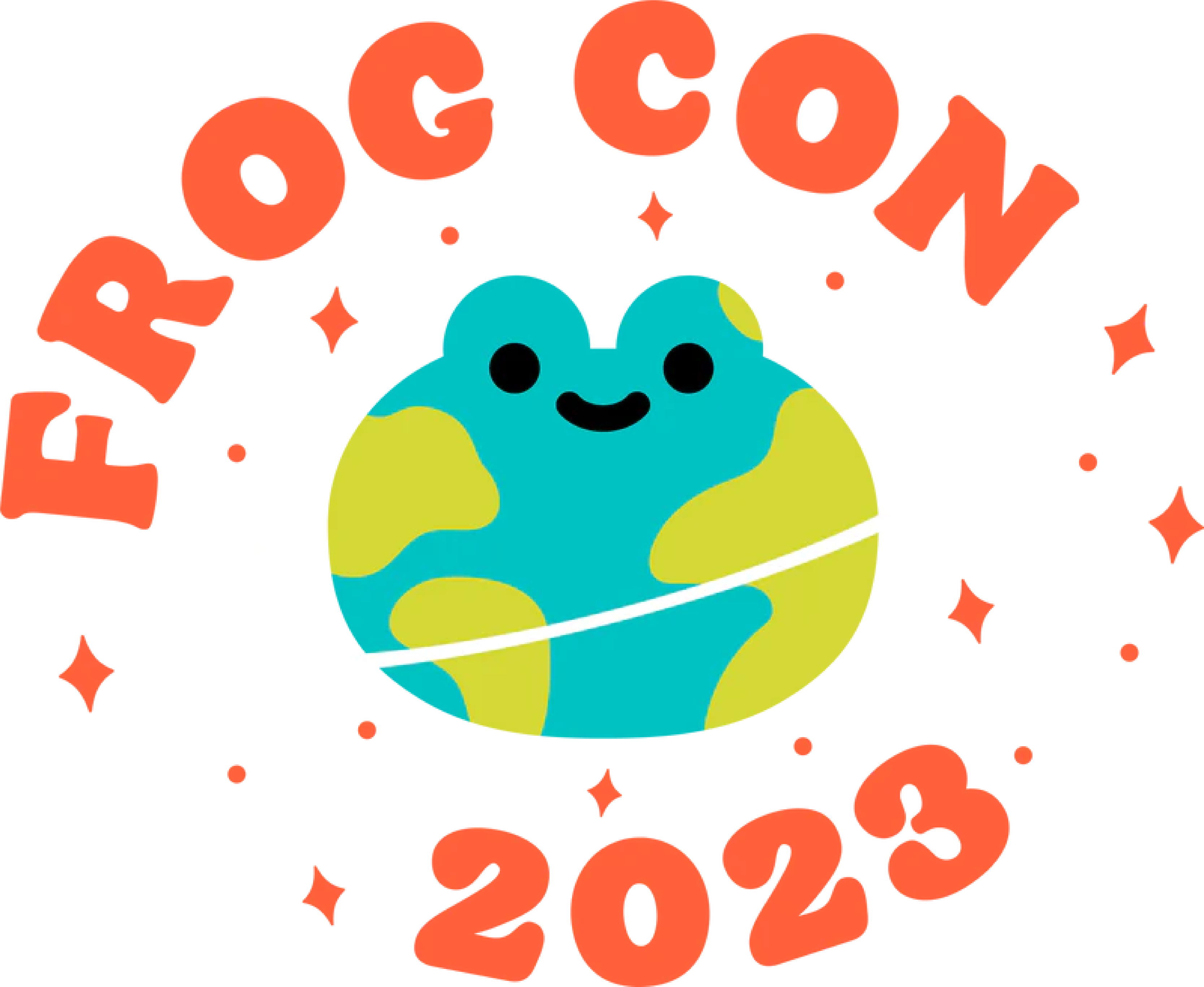
Future Leaders of Amphibian Conservation Program
The Amphibian Survival Alliance (ASA) welcomes applicants in the early stages of their careers who have a track record of contributing to successful conservation initiatives. The Future Leaders of Amphibian Conservation Program aims to support those who wish to conduct or continue initiatives that directly or indirectly impact the survival of amphibians in the wild. While anyone can apply, we are particularly interested in attracting delegates from amphibian-rich, resource-poor countries.
This program offers a range of opportunities throughout the year, including financial support for:
- Conference attendance
- Research projects
- Capacity-building initiatives
- ASA internship position
ASA is proud to announce two new opportunities for emerging leaders in the field of amphibian conservation. The call for applications is NOW OPEN.
Below you will find detailed information on each opportunity:
ASA is committed to supporting the professional development of future leaders in amphibian conservation. By offering this capacity building support opportunity, we aim to remove financial barriers to education and training in this critical field. ASA will cover the registration fees, up to USD 570, for selected courses designed to enhance the skills and knowledge essential for the conservation of amphibians. This financial support is a testament to our dedication to fostering the growth of knowledgeable and skilled conservationists, who are equipped to make a significant impact in the field.
PLEASE NOTE: Applicants who are already enrolled in any of the courses listed below as eligible for funding support at the time of their application are not eligible to receive financial support through this opportunity.
Below are the ONLY eligible courses for which applicants can seek funding support:
1. Facilitating Species Conservation Planning Workshops: Online Training Course
- Provider: Conservation Planning Specialist Group (CPSG)
- Supported Registration Fee: Up to USD 300
- Details: Introduction to CPSG’s species conservation planning processes and tools. Suitable for conservation professionals aiming to develop species conservation plans.
- Course Details
2. Wildlife Disease Risk Analysis: Online Training Course
- Provider: Conservation Planning Specialist Group (CPSG)
- Supported Registration Fee: Up to USD 500
- Details: Introductory course on the IUCN Guidelines for Wildlife Disease Risk Analysis, targeting conservation professionals and veterinarians for effective disease management.
- Course Details
3. Ex Situ Conservation Assessment: Online Training Course
- Provider: Conservation Planning Specialist Group (CPSG) in partnership with The Nature Conservancy
- Supported Registration Fee: Up to USD 300
- Details: Guides participants through evaluating ex situ conservation options, promoting collaboration for effective conservation strategies.
- Course Details
4. Endangered Species Recovery Course
- Provider: Durrell Wildlife Conservation Trust
- Supported Registration Fee: Up to the equivalent of USD 569 in GBP
- Details: Offers practical skills and critical understanding necessary for endangered species recovery, featuring live webinars and case studies.
- Course Details
ASA is dedicated to advancing amphibian conservation through scientific research. Our Research Project Funding Support Opportunity aims to empower emerging researchers by providing seed funding for innovative projects that have a direct impact on the conservation of amphibian species, particularly those facing critical threats. By offering this support, ASA seeks to catalyze significant advances in the field, helping to fill knowledge gaps and implement conservation actions based on sound science.
ASA will award up to USD 3,000 in seed funding for research projects focused on amphibian conservation. This support is intended to cover project costs including, but not limited to, fieldwork expenses, equipment, and data analysis tools.
Eligible research areas:
- In Situ Conservation: Projects aimed at conserving amphibians in their natural habitats.
- Ex Situ Conservation: Research focusing on the conservation of amphibians outside their natural habitats, including captive breeding and reintroduction programs, that have a direct impact on or application to In Situ populations.
- Threat Mitigation: Studies investigating threats to amphibian populations such as habitat loss, climate change, pollution, and disease.
- Species Recovery: Projects focused on the recovery of Critically Endangered amphibians, as identified in the State of the World’s Amphibians report, or those in Threatened Amphibian Locations (TALS).
APPLICATION DEADLINE: May 17th, 2024, 23:59 UTC. Please make sure to convert this deadline to your local time zone to ensure your application is submitted on time. Late applications will be dismissed.
HOW TO APPLY:
To apply for the CAPACITY BUILDING SUPPORT OPPORTUNITY, please complete our online application form HERE. The form will guide you to input your personal and professional details, select your preferred course, and articulate its relevance to your amphibian conservation goals. You will have the option to upload your CV and recommendation letters directly within the form. Ensure that all sections are completed accurately and that all necessary documents are attached before submitting your application by May 17th, 2024, 23:59 UTC.
To apply for the RESEARCH PROJECT FUNDING SUPPORT OPPORTUNITY, please complete our online application form HERE. The form will prompt you to provide comprehensive details of your research project. Additionally, you will be required to upload your CV, two recommendation letters, and the complete project proposal template (including the timeline/budget template which is to be pasted into that project proposal document) as outlined in the application requirements. Please review your application thoroughly to ensure completeness and adherence to the guidelines before submission. All applications must be submitted by May 17th, 2024, 23:59 UTC.
ELIGIBILITY CRITERIA:
- Applicants must select ONE of the above courses only and include in their application the chosen course and its relevance to their professional development in amphibian conservation.
- A brief overview of any previous related coursework and/or training.
- Curriculum Vitae (CV).
- Two recommendation letters, preferably from individuals familiar with the applicant’s work in conservation, such as academic advisors, professional supervisors, or peers in the conservation community. These letters should speak to the applicant’s commitment to amphibian conservation, their potential for leadership in the field, and how they stand to benefit from the chosen course.
- Successful applicants will be required to provide proof of course registration and a certificate of completion upon finishing the course.
- Applicants should have proficiency in English, as the courses will be conducted in English. This is crucial for ensuring that participants can fully engage with the course material and contribute effectively to discussions and activities.
ASA is committed to assessing the effectiveness and impact of our Capacity Building Support Opportunity. To facilitate this, successful applicants are required to provide a comprehensive report and feedback upon completion of their chosen course. This allows us to gauge the benefits of the training, understand how the knowledge gained is applied in practice, and refine future offerings to better serve the conservation community.
Upon completion of the course, recipients are expected to:
- Within one month of finishing the course, recipients must submit a report detailing their learning experiences, the knowledge and skills acquired, and how these will be applied to their current or future conservation projects. The report should be between 500 to 1000 words.
- Complete a feedback survey to evaluate the course content, instruction quality, and applicability to their conservation efforts. This feedback is crucial for ASA to ensure the quality and relevance of courses supported through this opportunity.
- Provide updates on how the course has influenced their conservation work up to one year after completion. This could be in the form of a brief email update, blog post, or any other format suitable for sharing insights and outcomes with the ASA and broader conservation community.
- A concise project proposal document, using only an ASA- provided template not exceeding four pages (including references) in pdf format, detailing the following sections:
-
- Project Title
- List of Researchers and Co-researchers
- 250-word Abstract
- 500-word Introduction
- Proposed Methodology
- Expected Results
- Timeline of Activities
- Detailed Budget
- Communication and Education Strategy
- References (using the Nature citation style only)
Applications that do not use the ASA-provided template will be dismissed. This template will be made available when the call for applications opens.
2. Curriculum Vitae (CV)
3. Applicants must provide two recommendation letters from academic advisors, professional supervisors, or peers in the conservation field. These letters should outline the applicant’s research abilities, dedication to amphibian conservation, leadership qualities, and how they could effectively utilize the seed funding to impact amphibian conservation positively. Recommendations should also highlight the applicant’s capability for clear communication and engagement relevant to their proposed project’s outreach components.
4. Applicants must specify the focus species, its conservation status according to the IUCN Red List and in the country of research and describe the expected conservation impact of the project.
Evaluation Criteria:
Projects will be assessed based on their potential impact on amphibian conservation, clarity and feasibility of the proposed research, and alignment with ASA’s conservation priorities. Special consideration will be given to projects that demonstrate innovative approaches and a strong communication component to raise awareness about amphibian conservation issues.
ASA places great importance on understanding and documenting the outcomes and impacts of the research projects we support. As part of our commitment to advancing amphibian conservation through scientific research, we require successful applicants of the Research Project Funding Support Opportunity to engage in thorough post-project reporting and feedback. These measures are essential for evaluating the effectiveness of our funding, sharing successes and lessons learned, and shaping future funding priorities.
Following the completion of their research project, recipients are required to:
- Halfway through the project timeline, recipients must submit a progress report that outlines the current status of the project, any preliminary findings, challenges faced, and adjustments made to the original plan.
- Submit comprehensive report detailing the research conducted, findings, and the implications of these findings for amphibian conservation must be submitted within two months of project completion. The report should include an abstract, methodology, results, discussion, and a conclusion, with a maximum length of 2000 words.
- Provide an assessment of how the research project has contributed to the conservation of amphibians, including any direct conservation actions influenced by the project’s outcomes.
- Complete a detailed survey regarding the funding process, administrative support, and any suggestions for improving the Research Project Funding Support Opportunity. This feedback is invaluable for ASA to enhance the support provided to future projects.
- Prepare a summary of their research findings for publication on ASA’s website or newsletter. This summary should be accessible to a broad audience, including non-specialists, to highlight the importance and impact of the research conducted.
- Should the results of your research be published in a scientific journal or presented in any professional scientific forum, it is mandatory to acknowledge the ASA’s contribution in the funding section of your publication or presentation.
The maximum funding available per grant will be determined on a cycle-by-cycle basis. Applicants will need to provide a clear budgetary breakdown in their application. Specific funding caps for each cycle will be announced prior to the application period.
This program specifically targets conservationists in the early stages of their careers. Typically, this would include individuals who have been active in the field for no more than 10 years post their last educational degree.
Applicants are required to review and commit to the ASA’s Future Leaders of Amphibian Conservation Code of Conduct. Please read and ensure your understanding of its principles, as your agreement to these terms is a prerequisite for grant consideration. The Code of Conduct is available for review and download here.
Frequently Asked Questions
The next call for applications will be announced on this page and across the ASA’s social media platforms when it opens. The next call for applications will open on April 12th, 2024.
Future Leaders of Amphibian Conservation grants are awarded in memory of Dr. George B. Rabb (1930-2017), a great supporter of amphibians and all those who care for them. This program is also directly supported by FrogCon, whose contributions have been invaluable in advancing amphibian conservation efforts.
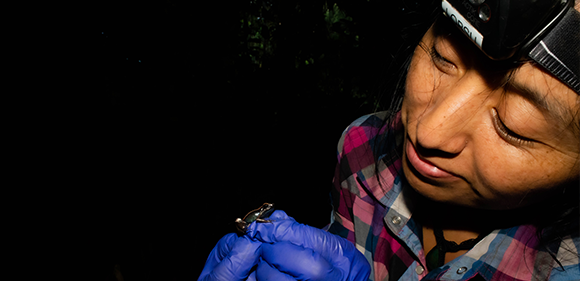
I am Shirley Jennifer Serrano Rojas, a Peruvian tropical ecologist and conservationist. I am currently working on my PhD in ecology and evolution at Stanford University. My research centers on understanding how global change, including climate change and land use change, is influencing amphibian behavioral response to novel environmental conditions. I am conducting my Ph.D. research in the Peruvian Tropical rainforest, working in close collaboration with local NGOs, and offering research opportunities to Peruvian undergraduate students. Throughout my research, I am using novel tracking methods to follow the behavior of small poison frogs. Using telemetry to track individual frogs offers a valuable opportunity to study their spatial utilization, movement patterns, habitat preferences, and behavior. This approach provides detailed insights into how species adapt to new environments and respond to global changes. Access to such detailed data enables us to better understand the mechanisms underlying physiological and behavioral flexibility, which is crucial for current and future conservation efforts. In conjunction with my research, I am committed to collaborating with local communities to ensure effective conservation. Together with local ambassadors, I will co-lead a citizen science project that will yield data on how frogs are adapting to modified ecosystems, shaping conservation efforts.
Photo © Jean Pier Zolorzano
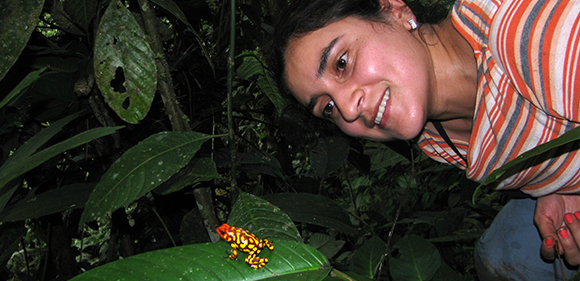
I am Mileidy Betancourth-Cundar, a Colombian behavioral ecologist. During my thirteen years as a Latin woman scientist, I have studied how human-induced rapid environmental changes have impacted amphibian populations, exploring changes in phenotypic, ecophysiological, genetic, and behavioral traits with a special focus on neotropical poison frogs. Most of these species, remarkably the more colorful and geographically restricted frogs, are heavily threatened by illegal wildlife trafficking. I have also contributed to establishing and strengthening community science initiatives for the conservation of amphibian species in their natural environment. From last year, I have been a member of the Orquídeas national program: Women in Science: Agents for Peace. My research is focused on understanding the effects of the contamination of rivers and forests by crude oil spills on amphibian populations from the Colombian Pacific region. Beyond research, my lifelong commitment is centered on actively contributing to the preservation of endangered amphibians. Through an interdisciplinary approach, I am focused on generating science-based tools to empower communities and local organizations for resource management and conservation programs in tropical forests in southern Colombia. I am dedicated to forging collaborative conservation initiatives aimed at establishing new protected areas, combating the illegal trade of poison frogs, and providing training for children and women in biodiversity conservation efforts.
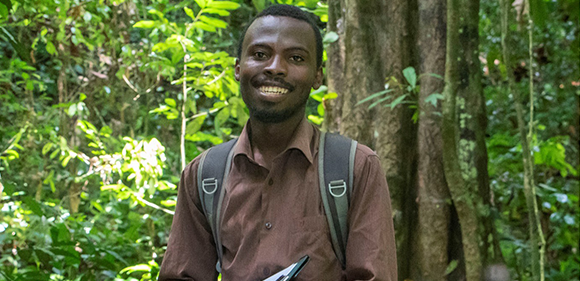
Francis Boafo Asamoah is from Asankragwa in western Ghana. He is finishing his MPhil in Wildlife and Range Management at the Kwame Nkrumah University of Science and Technology. Francis is an ecologist with a particular interest in Habitat & Species ecology and a newly developed interest in Urban ecology. He is also a conservation scientist, Protected Area Management enthusiast and a passionate Biodiversity Communicationist. Francis aims to bridge the gap between scientific knowledge and public understanding of environmental (biodiversity) issues. He wants to create awareness of amphibian and biodiversity conservation issues on a global scale. He aims to break down complex scientific findings into simple languages for policymakers and the general public, enabling evidence-based decision-making for conservation and biodiversity protection.
Through targeted communication campaigns, Francis aims to reach diverse audiences and inspire conservation action on a global scale. He envisages building solid partnerships with stakeholders and creating networks to amplify conservation messages while empowering the next generation of biodiversity communicators to continue to provide vital information for amphibian conservation. A famous quote by Theodore Roosevelt inspires him: “The wildlife and its habitat cannot speak, so we must and we will.
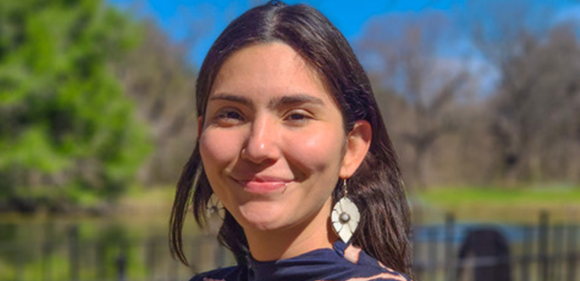
María del Mar Moretta-Urdiales is from Guayaquil, Ecuador, working on her Ph.D. in Aquatic Resources and Integrative Biology at Texas State University. She is an ecologist, conservation scientist, tree climber, and a disease ecologist (epidemiologist). As part of her research, she is studying the spread of diseases in amphibians living in the canopies of the remaining forests in Ecuador. Mar actively collaborates with Ecuadorian universities, NGOs, and local communities while offering research opportunities to Ecuadorian biologists, undergraduate students, and tree climbers. Her goal is to be a bridge between local communities, science, and conservation.
Mar is interested in understanding and measuring amphibian decline and possible undetected amphibian decline across the three regions of Ecuador, including spaces where amphibians are already affected by deforestation, such as urban forests. She aims to work with local stakeholders to advocate protecting the remaining forests in highly disturbed ecosystems while continuing to teach and mentor Ecuadorian biology students. You can learn more about her work by visiting her YouTube Channel.
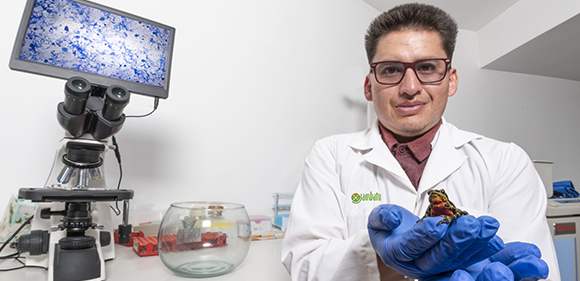
I am Renato Naranjo, an Ecuadorian biotechnologist, and I graduated from the Universidad de las Fuerzas Armadas ESPE. Since 2018, I have been actively engaged in research and conservation projects of Ecuadorian amphibians, working closely with the Centro Jambatu de Investigación y Conservación de Anfibios (CJ). My primary focus has been on the Development of Assisted Reproduction Technologies for the conservation of critically endangered species of harlequin frogs (Atelopus), I played a significant role in establishing the first amphibian reproductive (male) cell repository at the CJ. Through these endeavors, my passion for the maintenance and protection of wild species has taken root and flourished. Additionally, I collaborated on bioprospecting studies of peptides present in the skin secretions of Ecuadorian frogs, specifically exploring their antimicrobial capabilities.
My current interests are centered around managing amphibian population genetics and ensuring the perpetual maintenance of their diversity through genetic resource collections. For that reason, I will strive to continue and reinforce my academic knowledge through a graduate program. Moreover, one of my objectives is to broaden connections and networks through projects that involve conservation actions for species critically endangered, directing my efforts towards those species that receive little or no attention from the community to conserve them.
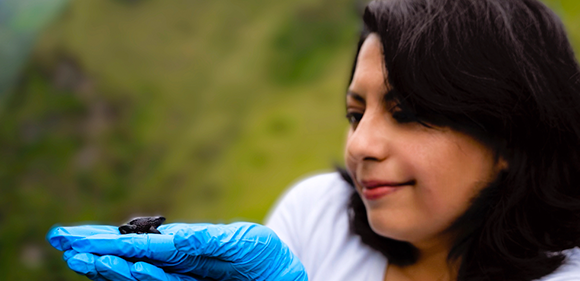
I’m an Ecuadorian biologist, educator, and conservationist with ten years of experience in environmental education projects. I pursued a master’s degree in Education, with a specialization in project management and coordination; and also, an MPhil. in Socio-environmental Studies. As a result of my research, the conservation project for the Jambato Harlequin Toad (Atelopus ignescens) was born. Since 2021, it has been implemented in Angamarca, Cotopaxi, the last refuge of this species. Through the development of this project, I learned to forge alliances and implement collaborative actions with an interdisciplinary approach. One of its main milestones is the creation of Alianza Jambato, an initiative that brings together an interdisciplinary team from national and international institutions, with the common goal of saving this emblematic species from extinction. Throughout my experience, I learned that close collaboration with local communities is essential for the success of conservation initiatives, as they are our best allies. I have received scholarships, grants, and awards for my work. But undoubtedly, the most rewarding recognition is contributing my bit to the conservation of a species that was once considered extinct and now is struggling to thrive. I have a firm commitment to continue working to save this and other endangered species from extinction.
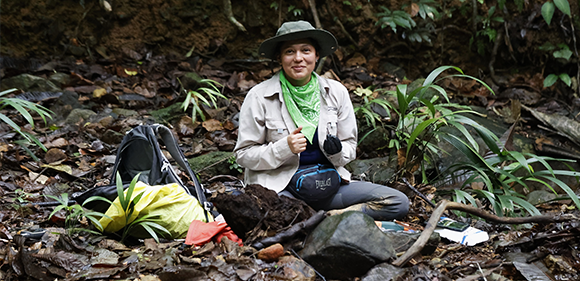
A graduate of the Autonomous University of Chiriquí (UNACHI), in Environmental Sciences and Natural Resources, she began her herpetological contributions working on the habitat preference and conservation of Atelopus glyphus, in Darién, Panama. Panamanian researcher, co-founder of La Fundación Los Naturalistas, an organization dedicated to the study of biodiversity and its conservation, where she mainly focuses on environmental education and citizen science. One of his main interests is showing the important value of amphibians and reptiles to children and adults. He continues his studies with A. glyphus by participating in a project on the thermal ecology of this species and the effects of climate change. Michelle has collaborated on other endemic amphibian conservation projects in her country, doing citizen science and promoting new products for sustainable tourism practices. He currently works at the interdisciplinary research and innovation institute UNACHI, where he conducts studies on the harlequin toad (Atelopus limosus), in the San Blas mountain range, where the main objective is to monitor the status of its populations, to create protected areas and integrate active activities. participation of populations in the conservation of the species.
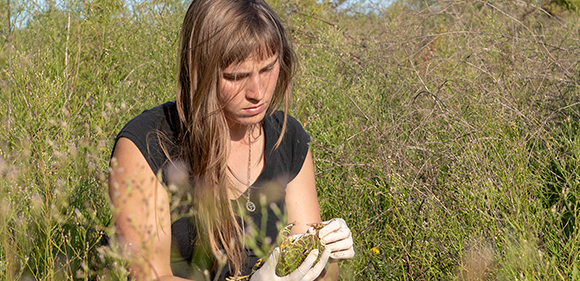
I am Camila Deutsch, a biologist graduated from La Plata National University and currently a doctoral student at University of Buenos Aires in Argentina. Since childhood, I’ve had a strong connection to nature, despite growing up in Argentina’s largest city. This led me to engage in various conservation projects as a volunteer and eventually pursue my bachelor’s degree in biology.
In 2014, I had the privilege of meeting Dr. Gabriela Agostini, a conservation biologist who introduced me to amphibian conservation in Buenos Aires’ agricultural landscapes. A year later, I initiated the Giant of the Pampas project, dedicated to generating evidence-based conservation actions for the Argentine Horned Frog (Ceratophrys ornata). This endeavor evolved into my doctoral thesis and has become a central part of my life.
This project is also part of COANA (Amphibian Conservation in Argentina), a broader initiative encompassing various amphibian conservation efforts across different eco-regions in Argentina. Throughout the years, my passion for collaborating with local communities and addressing the social dimensions of conservation projects has grown significantly.
Looking ahead, I am deeply committed to further enhancing my skills in community engagement, to establish effective, long-term conservation strategies for amphibian species of Argentina.
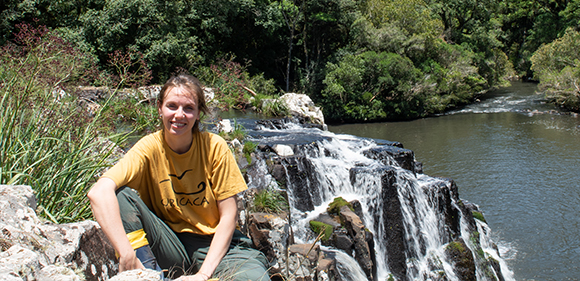
Michelle is a Brazilian PhD candidate and conservationist. Her interest in conservation arose in 2010, when she was an undergraduate student, because of an emblematic case in southern Brazil: a microendemic toad species was threatened by a hydroelectric enterprise. Since then, she has been an active member of the Admirable Red-Belly Toad project, one of the most successful conservation programmes in Brazil. Her first work with the Admirable Toad was collecting data to evaluate its conservation status. Currently, during her PhD, she is improving the knowledge about the breeding trigger of the species and studying the variations in population size to detect trends and assess extinction risk. Michelle also participates in the Conservation Center of Amphibians and Reptiles in an NGO, the Curicaca Institute, and in the National Action Plan for the herpetofauna of southern Brazil, where is planned conservation and environmental awareness actions about the Admirable Toad, as well as other amphibian and reptile species. In recognition of her work, Michelle was awarded with the Young Conservationist Prize in 2018 by the IUCN SSC Amphibian Specialist Group in Brazil.
Several unanswered questions remain about the distribution and the natural history of the Admirable Toad. Thus, Michelle aims to continue studying which variables determine the very restricted distribution of the species and searching other possible populations. In addition, her work in the Curicaca Institute includes a project to create a protected area in the locality of the unique known population of the species and, more recently, a project to minimize the problem with deforestation and pesticides around the breeding site of the species, rescuing the production of the native Yerba-Mate in agroforestry systems, as an alternative to monoculture of tobacco and soybean. She believes this change in local production will benefit both local people and the entire population of Admirable Red Belly Toad.
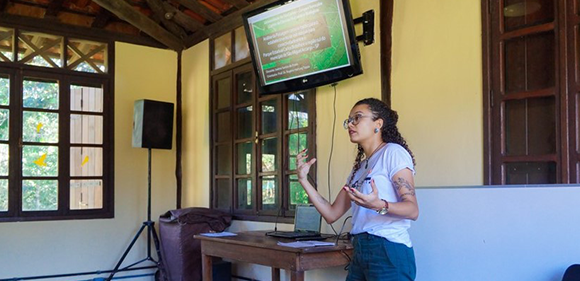
I am a Brazilian biologist working on amphibian Ecology and Conservation. As an undergraduate student, I have worked as a volunteer intern in Ecotoxicology of aquatic organisms, studying how xenobiotics affect amphibians. Also, I have collaborated in a State Park delineating an ecological corridor using geoprocessing tools, and I have volunteered in environmental education activities for children and adults. In 2022 I completed the degree of Master in Ecology, studying a possible new dispersion route of chytrid fungus by fog.
I have always studied in public schools. Because of my family and some good teachers, I had better opportunities and perspectives to pursue a technical and college education. But it was in 2020, on my first herpetological field trip that I found myself absorbed by the darkness of night and, at the same time, by the joy of being surrounded by animals in the woods. This peace of mind connected me back to nature. It is an individual right to know the world’s natural patrimony, so we should yield it to everyone else. That is why I want to provide the same to other people.
Nowadays I am part of the activities carried out by the Laboratório de História Natural de Anfíbios Brasileiros (LaHNAB). I offer courses about the disease chytridiomycosis, teaching new biologists about what subjects to work in to mitigate this threat. I also coordinate an amphibian survey project in a remaining habitat in Campinas, SP, Brazil. The objective is to promote citizen science, make the population aware of the native amphibian species, and train new biologists in herpetology.
In the future I intend to develop my academic career, carrying out scientific research focused on understanding and mitigating threats to amphibians, whether on amphibian infectious diseases or invasive species. I also want to carry out environmental education projects in public schools, teaching children about the importance of amphibians, promoting field activities, and taking them to know protected areas and amphibian species.
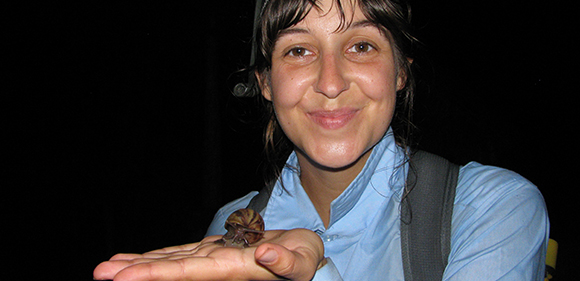
Dr. Kaya Klop-Toker is an early career conservation biologist specializing in population ecology and adaptive management of threatened amphibians. Kaya is passionate about understanding the often multi-faceted mechanisms behind amphibian decline, with her research having focused on disease, invasive species, habitat suitability, translocations, and mitigation. In 2016, Kaya completed her PhD at the University of Newcastle, Australia, on a project investigating the impact of disease and invasive fish on captive bred and released green and golden bell frogs (Litoria aurea). Preceding her PhD, Kaya completed an honours thesis in Adelaide, South Australia, investigating the ecology of a remote population of desert tree frogs. In addition to her own academic research, Kaya has worked for the New Zealand Department of Conservation on a project monitoring endangered native frogs, as well as several volunteer positions researching herpetofauna or endangered species in Madagascar, Western Australia, Bolivia, and Ecuador. Kaya is currently working as a post-doctoral researcher in the Conservation Biology Research Group at the University of Newcastle.
Kaya’s current research position is investigating the impact subsidence caused by longwall mining is having on the vulnerable stream breeding heath frog (Litoria littlejohni). Longwall mine subsidence causes hydrological changes to surface and ground water. These changes mainly consist of reduced flow or drying of swamps and streams, lowered below-ground water tables, and altered water quality. These impacts can be temporary, however permanent water loss is common. Kaya’s team aims to quantify the habitat disturbance of longwall mining within her study region and model L. littlejohni’s breedinghabitat requirements, population connectivity, and occupancy across the landscape, in order to determine the impact longwall mining is having on this, and co-occurring, frog populations.
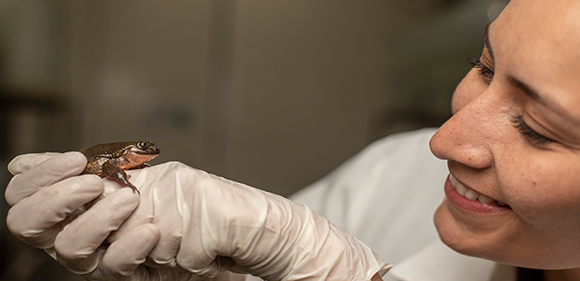
Teresa Camacho Badani is a Bolivian Biologist who started working with amphibians as undergraduate student in the Biodiversity and Genetics Center at the Universidad Mayor de San Simon documenting the population status, breeding phenology and activity patterns of threatened amphibian species found only in cloud forests of Bolivia. She obtained a Master’s degree in Conservation Biology at the Pontifical University of Ecuador in Quito and In the Herpetology Division of the QCAZ Zoology Museum held a study about Phylogenetics and Conservation of the Terrestrial Frogs of the Pristimantis conspicillatus species group.
She is currently Chief of the Herpetology Department at the Alcide d’Orbigny Natural History Museum (MHNC) in the City of Cochabamba and is in charge of the K´ayra Center, the only custody center exclusive for threatened amphibians in Bolivia that belongs to the same museum, in its ex situ program houses 450 individuals of 7 species. She is leading action plans for the conservation of Water Frogs of the genus Telmatobius, such as the critically endangered Titicaca Water Frog (Telmatobius culeus) with which she has begun working with colleagues in Peru to execute binational conservation actions. She is also is working with the Sehuencas Water Frog (Telmatobius yuracare) Action Plan, a single individual known as Romeo “the loneliest frog in the world” which had lived alone for over 10 years in the captive breeding program of the MHNC and had been considered the last of his kind, after a successful innovative online fundraising campaign to finance expeditions to find another Sehuencas water frog – a ‘Juliet’ for ‘Romeo’, a population in the wild has been found and with the help of Global Wildlife Conservation a holistic conservation action Plan is being implemented, which includes work with local communities, monitoring populations in the field and an ex situ program to bring this species back from extinction.
Teresa has been recognized by the Departmental Autonomous Government of Cochabamba and Departmental Secretariat of Mother Earth for her “Contributions to the research of our relationships with animals and Earth”, awarded an “Environmental Merit” by the Honorable Municipal Council of Cochabamba for her work in amphibian conservation. She was also recognized as Disney Conservation Hero for the Disney Conservation Fund and is an Amphibian Advocate of the Amphibian Ark.
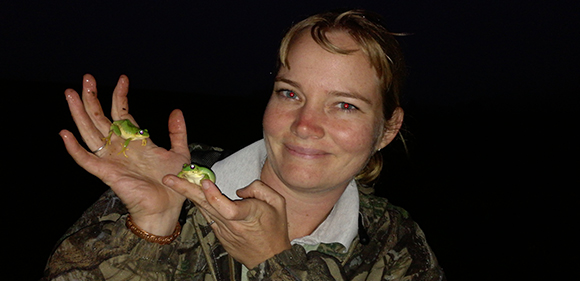
I was fortunate enough to grow up in a conservation family, situated in a piece of paradise called Kosi Bay, which is a nature reserve on the Mozambique boarder. We lived and breathed conservation every single day of our lives growing up, between the rescued animals we were raising, the on-going anti-poaching and tagging project that my father ran and assisting with visiting scientist’s field trips. It was an enchanted childhood that I was able to extend by studying my undergrad via correspondence and remaining at Kosi. This enabled me to assist and be involved with so many amazing projects and experiences including Nile crocodile telemetry, relocation and tissue sampling, rhino capture and translocation, rare, threatened and endemic species assessments, various fish telemetry and research projects and many other smaller projects and conservation initiatives. My main love was always herps though and after meeting and assisting Prof. Louis Du Preez with fieldwork, my focus became frogs.
All these experiences only added to the passion I have for conservation and research and when I finally left Kosi and was offered the opportunity to read for my honours degree under a Professor who had always been one of my heroes, (Louis) I couldn’t believe my luck. I completed my BSc honours degree last year, with a research project based in Zimbabwe using passive acoustic monitoring to establish amphibian species abundance and diversity on the farm. It was an amazing experience and was the start of my love for the academic side of research. Since then I have been working on my Masters project which is based on an endangered species found in the foothills of the mighty Drakensberg Mountains. Once again I can’t believe my luck to be able to do such an amazing project on a species I had already fallen in love with years before, and which enables me to combine three of my favourite subjects, research on the frog itself, how we can better conserve this endangered species and the creation of resources to educate people about the important role that frogs play in the wetlands.
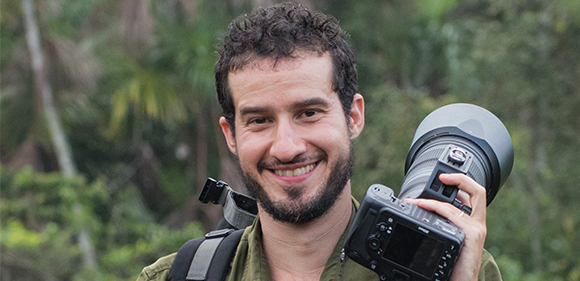
Pedro is a zoologist working on the global diversity, evolution and conservation of amphibians and reptiles. He often participates in scientific expeditions to remote corners of the World, where he conducts biological surveys in search of new, rare and endangered wildlife. His current research integrates the use of anatomy, genetics and ecology to assess the species diversity across South America. His work resulted in the discovery of over 20 new species of frogs and lizards (mostly from Amazonia), some of which are threatened with extinction. Pedro received his PhD in Comparative Biology from the American Museum of Natural History (New York, USA) and is a professor in the Graduate Program in Zoology at Universidade Federal do Pará (Belém, Brazil).
Peloso is also a talented photographer—he uses his images to produce visual stories about the diversity and conservation of animal species, and their habitats, in Brazil. He is the creator and coordinator of the Documenting Threatened Species (DoTS) project. DoTS is a bold initiative to document and study all threatened species of amphibians in Brazil. The project was launched in 2018 and is largely a conservation photography initiative. However it also aims to conduct the first thorough assessment of Batrachochytrium dendrobatidis (Bd) infections in the species officially listed as threatened with extinction in the Brazilian RedList.
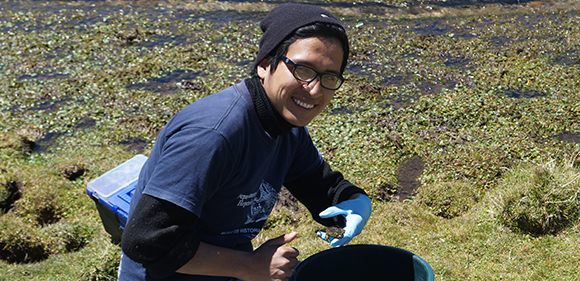
I am a zoologist working on taxonomy, ecology, citizen science and conservation of amphibians. I am the co-founder of the NGO Grupo Rana, an ASA partner, and also a project coordinator for the Denver Zoo in Junin, Peru. At Grupo Rana, I execute the conservation program of two endangered water frogs (Telmatobius macrostomus and Telmatobius brachydactylus) in the Lake Junin. Besides monitoring these frogs, I am responsible for environmental education activities and resources management with local people.
My current research integrates populations dynamic, taxonomy and development of tadpoles, and citizen science activities like eco-tourism and volunteering. One of my works resulted in the taxonomic description of the tadpole of Telmatobius brachydactylus. I have also co-organized BIOBLITZ expeditions to the high Andes in the centre of Peru in 2017 and 2019. In 2018, I was a NatGeo explorer within Grupo Rana, and we discovered new places with endangered frogs, which will be monitored in the future. In April 2019, we started our citizen science program, funded by the Rufford Foundation. To increase funding for this project, we also launched a crowdfunding campaign and sold souvenirs. I am currently a Master student at the Universidad Nacional Mayor de San Marcos (Lima, Peru) and my project aims to create a protocol (for scientists and citizens) to monitor water frogs, which will include a field guide for local people. Our goals for the next years are to maintain ecologically viable populations of both water frog species, to fill information gaps about their ecology, to create a conservation centre for their ex-situ breeding and to implement the citizen science monitoring program.
I am also a collaborator researcher at the Herpetology Department of the Natural History Museum in Lima, and a member of the IUCN SSC Amphibian Specialist Group (ASG) for Peru. Within ASG, we are currently developing research and education activities to disseminate information about Peruvian amphibians.

Since 2016, Trinity has been the Mayor of Amphibiville for the Detroit Zoological Society’s National Amphibian Conservation Center. Her project uses a three-prong approach to conservation: 1) to raise social awareness for amphibian and wetland conservation through social media posts and implementing her “Amphibian Conservation Rocks” painted rocks campaign, 2) to conduct field research and clean up local wetlands, educate and inspire her classmates about amphibian conservation, and collect valuable field-data as a citizen scientist for FrogWatch USA, and 3) raising political awareness for amphibian conservation.
In 2018, Trinity won the Detroit Zoo’s conservation essay contest again; so her mayoral role was extended another two-year term. Trinity continues her conservation work this year by expanding her Amphibian Conservation Rocks campaign and running her own amphibian conservation Instagram hub and website actionforamphibians.com. She is poised to promote relevant amphibian conservation issues to young people world-wide.
Trinity’s conservation efforts have appeared in numerous publications and media outlets including: Metro Times, Detroit Free Press, Detroit News, Shelby News TV, WDIV news, WXYZ news, FOX News, Metro Parent Magazine, and C&G News. Along with the Detroit Zoo, she also collaborated on a video PSA and signed an Executive order to stop Bill 316 in Michigan’s Senate. She continues to receive honors and recognition from many distinguished politicians and organizations including: ACRS Future Leaders of Amphibian Conservation scholarship, recipient of John Muir Environmental Youth Advocacy Award, recipient of the Daily Points of Light Service Award, and even recipient of the President’s Environmental Youth Award.
Trinity’s goal is to reach and inspire a new generation and to continue to contribute to amphibian and wetland conservation.
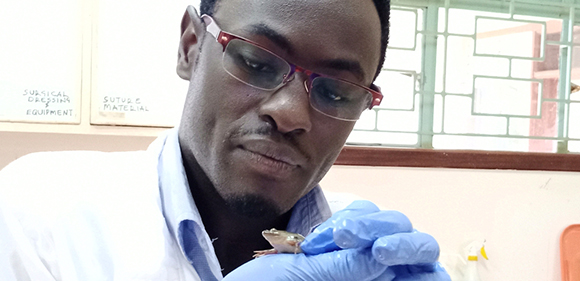
Dr. James Watuwa is a wildlife veterinarian who grew up in Uganda where his love of animals began early in life. His childhood was spent caring for a variety of animals from cats and dogs to tadpoles, snakes, and birds. Following high school, Dr. James Watuwa attended Makerere University in Uganda where graduated with a Bachelor’s Degree of veterinary medicine and later completed his Master’s Degree of science in wildlife health and management in 2018
Throughout his five years of vet school, he donated his time to the Uganda Wildlife Conservation Education Centre (Entebbe -Zoo) helping to diagnose, treat, and medicate all zoo animals suffering from disease, injury and provided medical care to hundreds of rescued and endangered animals. He reprised this role helping to care for endangered wildlife when he served as wildlife Veterinarian at Conservation Through Public Health in Bwindi Impenetrable National Park
In 2018, Dr. James Watuwa was the first African student to earn a Veterinary-track scholarship under the Wildlife Conservation Network Scholarship Program and this saw him complete his Master’s Degree of science in wildlife health and management. Following-up on this he subsequently became Founder and Chief Executive Officer of Elgon Wildlife Conservation Organization https://www.elgonwildlifeconservation.org) with a mission to promote biodiversity and wildlife conservation through community engagement, recognizing the importance of engaging people in protecting wildlife, while supporting sustainable development using a holistic and multi-disciplinary approach both of which are critical for the conservation of wildlife.
Dr. James Watuwa is dedicated to the conservation of all reptiles and amphibian diversity in Uganda by promoting the conservation of the amphibian and reptiles and their natural ecosystems and implementing positive change in human attitudes towards the amphibian and reptilian diversity in Uganda.
When not at work, Dr. James Watuwa can usually be found taking care of his own menagerie of animals which includes birds, cats, dogs, fish, lizards, and hedgehogs. He also enjoys nature walks, listening to music and just hanging out with family and friends.
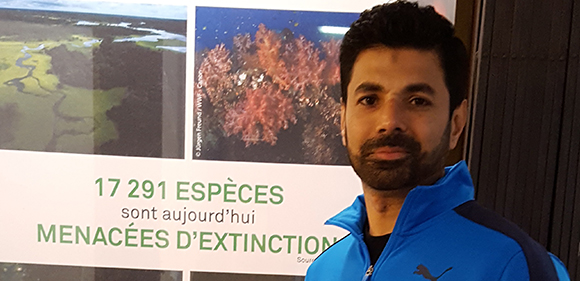
Dr. Muhammad Rais has been working in the Department of Wildlife Management, PMAS-Arid Agriculture University Rawalpindi, Pakistan, since 2007. He opted to teach and carry out research in one of the poorly studied and often neglected groups of wildlife of Pakistan-Herpetofauna. Since 2007, as many as 21 MPhil and 5 MSc students have benefited from his supervision while 5 PhD and 6 MPhil scholars are currently enrolled with him. The awardee organized an international seminar (April, 2018) and a field activity (May, 2018) with an aim to integrate amphibians and reptiles in wildlife conservation in Pakistan. He established linkages with herpetologists in Deakin University Melbourne and University of Canberra, Australia; Purdue University, USA and researchers in India, Sri Lanka, South America and Europe. He obtained professional foreign trainings in herpetology from India and USA. The applicant won Australia’s prestigious Endeavor Post-doc scholarship (6 months, 2014-2015). He has published over 40 research articles in journals and several newspaper and magazine articles. He designed courses such as Herpetology, Conservation Biology and Wildlife Data Analysis for post-graduate students of wildlife degree programs. The awardee has represented Pakistan at national (8 oral and 1 poster presentations) and international conferences (5 oral and 2 poster presentations). He has just completed an international research project (funded by International Foundation for Science, Sweden) on amphibian ecology and conservation. He is currently executing research project dealing with taxonomy (including molecular taxonomy), distribution, occupancy modeling, home range, population monitoring and impact of land use, land cover change and climate change on amphibians. He was the focal person of two research projects (National Geographic Society and Rufford) carried out by a PhD scholar of Deakin University in 2018 summer. He provided training on wildlife field techniques and data analysis to personnel from Punjab Wildlife and Parks Department sponsored by Punjab Wildlife Research Centre Gatwala, Faisalabad, Pakistan. The awardee successfully applied research tools such as bioacoustics, animal marking through PIT tags and Visible Implant Elastomers, radio-telemetry and eDNA on amphibians for the first time in the country. He has three gold medals to his credit. He is a member of IUCN amphibian specialist group, and is serving as a member of executive council of Zoological Society of Pakistan.
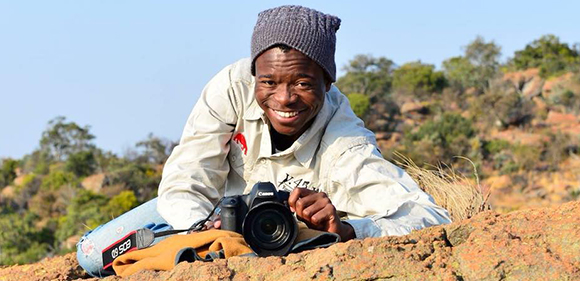
Fortunate Mafeta Phaka is the author of South Africa’s first bilingual frog book and a PhD candidate in Environmental sciences at Hasselt University and North-West University. His rural upbringing instilled a childhood fascination with wildlife and the career in conservation began with work in the wildlife film industry while studying towards an undergraduate degree. Wildlife filmmaking continues to be his first love and he now uses it along with social media and photography as conservation communication tools. His work and studies have earned him multiple accolades including National Wetland Indaba’s Young Professional Award, Amphibian Research Conservation Symposium’s Future Leader of Conservation Award and a place among Mail and Guardian’s Top 200 Young South Africans for 2016.
Fortunate’s current research project investigates the complex interactions between people’s cultures and the diversity of frogs and reptiles in South Africa. For a multi-cultural society such as South Africa this research can ultimately contribute to more socially just conservation policies and increased inclusion of non-scientist in biodiversity matters. One of the first outcomes of this current research is a peer-reviewed article that formulates guidelines for the compilation of a comprehensive list of indigenous names for South Africa’s amphibians in the country’s nine indigenous languages.
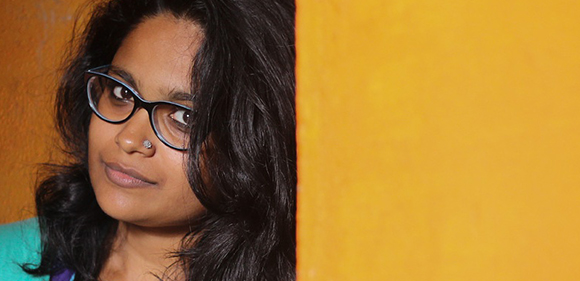
Bio
I am a wildlife conservation researcher from Kerala, India. I have an MS in Ecology and environmental sciences from Pondicherry University, India. I joined the Conservation Research Group (Kochi), as a Research Associate and worked on community-related conservation projects such as understanding the wild meat utilization by indigenous communities, enhancing biodiversity conservation and local livelihoods in the Anamalai corridor by improving non-timber forest produce collection and ecotourism, enhancing the conservation of the toad-skinned frog and understanding local perceptions of cardamom consumption by amphibians in the Western Ghats. I have also worked on understanding perceptions of indigenous communities towards wild meat consumption across the Western Ghats. I am currently working on a project, which focuses on improving the appreciation of frogs amongst children and reducing the utilization of Nasikabatrachus sahyadrensis through a book reading campaign.
Summary of the current project
The Endangered purple frog (Nasikabatrachus sahyadrensis) is an evolutionary distinct, fossorial amphibian discovered by the scientific community in 2003. However, it was well known among indigenous communities much before its scientific discovery. Numerous generations (current and past) of these communities understand its behaviour and ecology, consume the frog and use it in traditional medicine and as amulets for children to overcome their fear of thunderstorms. There is an urgent need to conserve this threatened species and this project initiates its conservation across the Western Ghats through education campaigns with indigenous communities to reduce their use as amulets and traditional medicine. This project aims to build appreciation and improve the profile of the purple frog and amphibians as a whole, thereby improving local support for amphibian conservation in the Western Ghats.The campaign involved 1597 children. A 146% increase in appreciation of the purple frog among lower primary children (aged 6-9), a 240% increase among upper primary children (aged 10-13) and 150 % increase among adults of indigenous communities were observed post the campaign. Most amphibian-related initiatives in India currently involve research and lack direct conservation. Though habitat loss and deterioration have been listed as threats for most amphibian species, very few initiatives actually mitigate this.
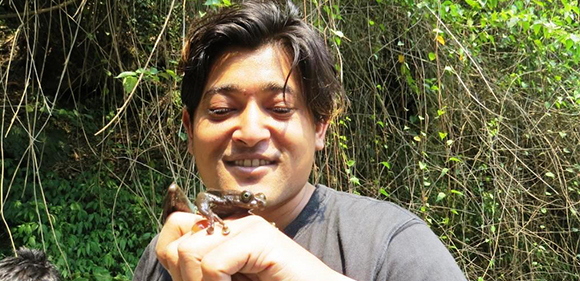
My name is Biraj Shrestha and I belong to the central Nepal from a small town called Hetauda. I have been a long-time volunteer for the non-profits, SAVE THE FROGS! that exclusively works for amphibian conservation around the globe. However, I am leading the amphibian conservation initiatives in different regions of Nepal since 2013. I earned my Master’s degree in Environmental Science from Khwopa College, Bhaktapur in the same year. To date, I have educated thousands of uninformed public about amphibian conservation through holding the annual Save The Frogs Day events in Nepal. In addition, I have extensively studied frogs across the country from the lowlands to the foothills of the Himalaya.
I work at the intersection of finding a sweet spot between research and conservation while understanding the anthropogenic influence in amphibian populations. The case of stream dwelling Paha frogs (from the genus Nanorana, Ombranaand Amolops), for instance that are harvested by local communities in the lower Mt Manaslu region, Nepal. Hunting paha is largely recreational and carried out for the purpose of food as a delicacy and very few people derive therapeutic benefits out of it. The rates at which species are harvested are unchecked and lack documentation. This spells a grave danger to frog populations of Nepal amidst the rapid decline of global amphibian populations. Echoing that, I am also involved in studying paha hunting and utilization by local community in Bhojpur district. While I am also involved with the phylogenetic studies of high altitude lake endemic frogs from Rara National Park at an elevation of nearly 3,000 meters above the sea level. Finding will be the baseline of DNA sequences for these endemic frogs that will reveal important questions of its lineage, population structure, evolution and many more.
Currently, I am pursuing my second Master’s degree as Coastal Science and Policy Program in the University of California, Santa Cruz. With the support of this program, I intend to study and design a freshwater biodiversity conservation model, particularly for river systems in Nepal coupling with Social Ecological Systems (SES) framework.
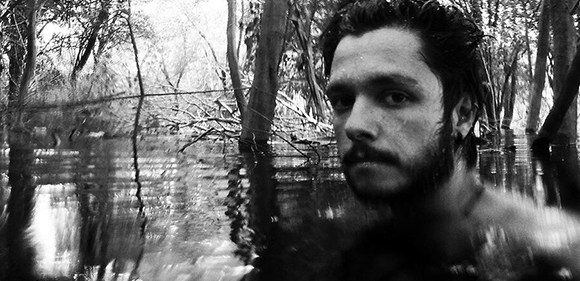
Luis is a Brazilian biologist working since 2003 with amphibians. He graduated and completed his master’s degree at the Universidade Federal do Rio Grande do Sul (UFRGS) in the far south of Brazil. Currently, he is finishing his PhD on biogeography of Amazonian amphibians at the Universität Trier, in Germany.
Among many projects, he works on one of the most successful amphibian conservation programmes in Brazil: the Admirable Red-Belly Toad project. Currently, he also collaborates with the Giant of the Pampas initiative, which aims to protect the Horned Frog in South America.
Since 2014, he has been a member of the IUCN SSC Amphibian Specialist Group, collaborating with its Brazilian regional branch (ASG Brasil). In recognition of his work, in 2017 he was awarded the ACRS Future Leader of Amphibian Conservation prize. Since 2018, he also collaborates with the Amphibian Survival Alliance in the Communication Programme.
Loving people as much as he loves amphibians, Luis believes that only education can give us a brighter future. He is also very interested in bringing people together and working in collaborative and multi-disciplinary groups.
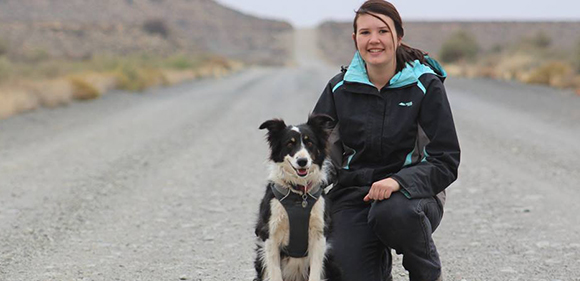
Esther Matthew grew up in central South Africa and became fascinated with nature and animals at a very young age. Following High school, Esther pursued degrees in Zoology, Physiology, Biodiversity and Conservation Ecology. In 2015, Esther completed her M.Sc. in Environmental Science. As part of her studies she successfully raised and trained a scent detection dog to locate Giant African Bullfrogs (Pyxicephalus adspersus) underground. The project ignited Matthew’s interest in training canines for conservation and research. As a result, Matthews pursued additional training with national and international professionals in the canine behavior and scent detection fields.
Matthew joined the Endangered Wildlife Trust’s Drylands Conservation Program (EWT-DCP) in 2016 and is currently working as their Specialist Conservation Officer, focusing on in situ Endangered species conservation and research. Esther also has a passion for sharing conservation knowledge. As such she works closely with learners from local schools, taking them into the field to teach them about nature through environmental education. Matthews coordinates the program’s volunteer project, aimed at exposing young career conservationists to field work in the Karoo.
Esther is a National Geographic Society Explorer and a highly dedicated and motivated conservationist. Esther aims to become one of the leaders in conservation canine research, because she is passionate for wildlife, conservation and research. She has an aptitude for the application of novel approaches in her work. Her enthusiasm and drive motivates other team members and her strong foundation in conservation biology allows her to lead by example.

I am the Curator of Reptiles and Amphibians at Africam Safari Zoo in Mexico since 2012. Since that time I have run a Conservation Program for the Large Crested Toad, a critically endangered amphibian endemic to Mexico. I had participated in the beginning of that program while I still was a volunteer at the zoo. I collaborated in the field work when the founders of the colony were collected. Unfortunately, when I got the position, the toads were still in quarantine boxes, but that gave me the opportunity to design their enclosures and form two breeding groups. Six months later, we had the first breeding event of the species in captivity. That event meant a huge learning experience for me, because I was able to see the toads laying eggs and the tadpole development since the beginning.
Since that day, we have had eight breeding events of the captive colony, which have allowed us to gather important information on the species breeding and developmental biology. We have collected tadpoles to enrich the gene pool of the colony and we have released more than 1000 captive bred toads in five different events between 2013 and 2017. Also, during these five years we have establish a permanent monitoring of the toad’s population finding an increase on the species abundance during the breeding season from 23 to 120 in a single night.
Besides working with the Large Crested Toad, I started a new project in 2015 with support from the ZSL’s Edge of Existence Program. This project consisted in a diagnosis of the situation of Taylor’s salamander population endemic to a single crater lake in Mexico. After two years working on that, I developed a conservation strategy in order to implement protection actions in the salamander’s habitat and to create an assurance colony of the species. By the end of last year, I got the “For the Love of Mexico Award” from Volkswagen. The award consisted in funding to continue working on the Taylor’s salamander habitat protection through actions such as the creation of a protected area around the lake, the reforestation of the crater with 2500 native trees and the engagement of local people and visitors in actions to reduce the pollution in the lake.
I hope my efforts can improve the conservation status of the species I work with (Taylor’s Salamander and the Large Crested Toad). In addition, I hope I am able to work for the conservation of other Mexican endangered amphibians in the future. Amphibians are not usually among the most important species for national conservation priorities in many countries. However, they are an outstanding group of animals due to their beauty, their different life histories and the role they play in the ecosystems. Amphibians deserve our protection.

